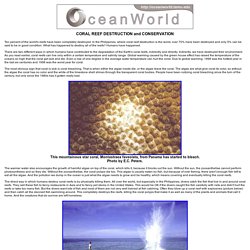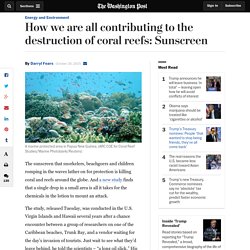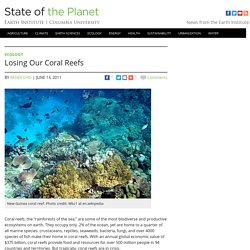

CORAL REEF DESTRUCTION AND CONSERVATION - Coral Reefs - Ocean World. CORAL REEF DESTRUCTION and CONSERVATION Ten percent of the world's reefs have been completely destroyed.

In the Philippines, where coral reef destruction is the worst, over 70% have been destroyed and only 5% can be said to be in good condition. What has happened to destroy all of the reefs? Humans have happened. There are two different ways in which humans have contributed to the degradation of the Earth's coral reefs, indirectly and directly.
The most obvious sign that coral is sick is coral bleaching. This mountainous star coral, Montastraea faveolata, from Panama has started to bleach. The warmer water also encourages the growth of harmful algae on top of the coral, which kills it, because it blocks out the sun. The direct way in which humans destroy coral reefs is by physically killing them. Dynamite not only kills the fish that live in the reef, but the reef as well. Another way that divers catch coral reef fish is with cyanide. Courtesy Jennifer M. 1. 2. How we are all contributing to the destruction of coral reefs: Sunscreen. A marine protected area in Papua New Guinea.

(ARC COE for Coral Reef Studies/Marine Photobank/Reuters) The sunscreen that snorkelers, beachgoers and children romping in the waves lather on for protection is killing coral and reefs around the globe. And a new study finds that a single drop in a small area is all it takes for the chemicals in the lotion to mount an attack. The study, released Tuesday, was conducted in the U.S. Virgin Islands and Hawaii several years after a chance encounter between a group of researchers on one of the Caribbean beaches, Trunk Bay, and a vendor waiting for the day’s invasion of tourists. Not only did the study determine that a tiny amount of sunscreen is all it takes to begin damaging the delicate corals — the equivalent of a drop of water in a half-dozen Olympic-sized swimming pools — it documented three different ways that the ingredient oxybenzone breaks the coral down, robbing it of life-giving nutrients and turning it ghostly white.
(Reuters) business. CORAL REEF DESTRUCTION AND CONSERVATION - Coral Reefs - Ocean World. CORAL REEF DESTRUCTION and CONSERVATION Ten percent of the world's reefs have been completely destroyed. In the Philippines, where coral reef destruction is the worst, over 70% have been destroyed and only 5% can be said to be in good condition. What has happened to destroy so many reefs? Human population has become very large, and earth is warming. 5 Causes of Coral Reef Destruction. Losing Our Coral Reefs. New Guinea coral reef.

Photo credit: Mbz1 at en.wikipedia Coral reefs, the “rainforests of the sea,” are some of the most biodiverse and productive ecosystems on earth. They occupy only .2% of the ocean, yet are home to a quarter of all marine species: crustaceans, reptiles, seaweeds, bacteria, fungi, and over 4000 species of fish make their home in coral reefs. With an annual global economic value of $375 billion, coral reefs provide food and resources for over 500 million people in 94 countries and territories. Fast facts: why coral reefs are important to people. Destruction of Coral Reefs. International Coral Reef Initiative. Coral reefs are often called the rainforests of the sea, both due to the vast amount of species they harbour, and to the high productivity they yield.

Aside from the hundreds of species of coral, reefs support extraordinary biodiversity and are home to a multitude of different types of fish, invertebrates and sea mammals. Covering less than one percent of the ocean floor, reefs support an estimated twenty-five percent of all marine life, with over 4,000 species of fish alone. Reefs provide spawning, nursery, refuge and feeding areas for a large variety of organisms, including sponges, cnidarians, worms, crustaceans (including shrimp, spiny lobsters and crabs), molluscs (including cephalopods), echinoderms (including starfish, sea urchins and sea cucumbers), sea squirts, sea turtles and sea snakes. Reef structures play an important role as natural breakwaters, which minimize wave impacts from storms such as cyclones, hurricanes or typhoons.